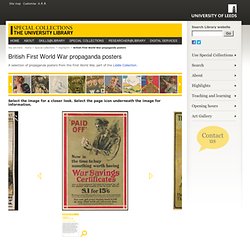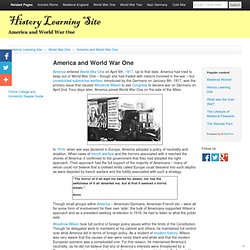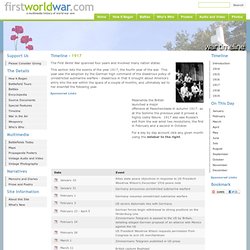

British First World War propaganda posters. Designed by Arthur Wardle and published by the Parliamentary Recruitment Committee in 1915, this poster demonstrates that the recruitment drive during the First World War was not limited to British citizens.

It attempts to foster a sense of unity between the dominions of the British Empire against a common enemy. At the outbreak of the First World War on 4 August 1914 the entirety of the British Empire was automatically deemed to be at war with Germany. However, self-governing dominions such as Canada, India, South Africa, Australia and New Zealand could choose whether or not to offer military assistance. A later version of the poster simply read "Overseas States" where before India, Canada, Australia and New Zealand were listed; South Africa had initially hesitated to become involved in the conflict and was left out of Wardle's original design.
Newfoundland Park's karibou, the Somme, March 2014. Vimy Ridge, the Somme, March 2014. First World War: Strategy and Tactics. Russia and World War One. World War One was to have a devastating impact on Russia.

When World War One started in August 1914, Russia responded by patriotically rallying around Nicholas II. Military disasters at the Masurian Lakes and Tannenburg greatly weakened the Russian Army in the initial phases of the war. The growing influence of Gregory Rasputin over the Romanov’s did a great deal to damage the royal family and by the end of the spring of 1917, the Romanovs, who had ruled Russia for just over 300 years, were no longer in charge of a Russia that had been taken over by Kerensky and the Provisional Government. By the end of 1917, the Bolsheviks led by Lenin had taken power in the major cities of Russia and introduced communist rule in those areas it controlled.
Impact of entry and exit 1917. America and World War One. America entered World War One on April 6th, 1917.

Up to that date, America had tried to keep out of World War One – though she had traded with nations involved in the war – but unrestricted submarine warfare, introduced by the Germans on January 9th, 1917, was the primary issue that caused Woodrow Wilson to ask Congress to declare war on Germany on April 2nd. Four days later, America joined World War One on the side of the Allies. In 1914, when war was declared in Europe, America adopted a policy of neutrality and isolation. When news of trench warfare and the horrors associated with it reached the shores of America, it confirmed to the government that they had adopted the right approach. Their approach had the full support of the majority of Americans – many of whom could not believe that a civilised entity called Europe could descend into such depths as were depicted by trench warfare and the futility associated with such a strategy.
The same was not true with regards to Britain. Sir Douglas Haig. Sir Douglas Haig (1861-1928), the most controversial of the war generals, was born in Edinburgh on 19 June 1861.

He studied first at Brasenose College, Oxford, and then in 1884 at the Royal Military Academy (Sandhurst). He passed out of Sandhurst in under a year, joining the 7th (Queens Own) Hussars. He served there as a cavalry officer for the following nine years, chiefly in India. Haig took part in the Omdurman campaign of 1897-1898, and in the Second Boer War of 1899-1902, where he served under Sir John French. Timeline - 1917. The First World War spanned four years and involved many nation states.

This section lists the events of the year 1917, the fourth year of the war. This year saw the adoption by the German high command of the disastrous policy of unrestricted submarine warfare - disastrous in that it brought about America's entry into the war within the space of a couple of months, and ultimately led to her downfall the following year. Meanwhile the British launched a major offensive at Passchendaele in autumn 1917: as at the Somme the previous year it proved a highly costly failure. 1917 also saw Russia's exit from the war amid two revolutions, the first in February and a second in October. For a day by day account click any given month using the sidebar to the right. 3 British Officers were executed by courts martial during the war, as opposed to 316 Private soldiers and 24 Non-Commissioned Officers.